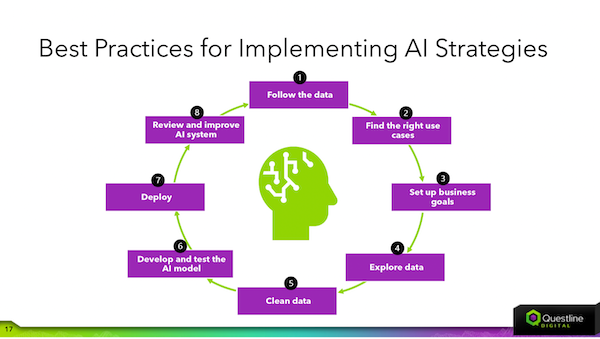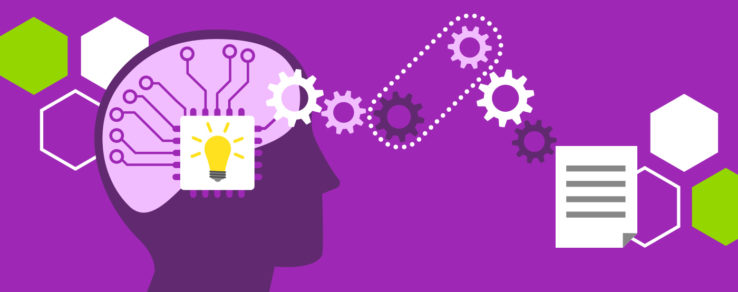Artificial intelligence (AI) is transforming various industries, including energy utilities, by offering innovative ways to improve the customer experience, enhance efficiency and streamline communications.
Our recent webinar, “Boost Customer Engagement with AI,” shared expert insights from Questline Digital’s Brian Lindamood, VP of Marketing and Content Strategy, and Zach Hardison, VP of Innovation. They explored how AI can be used tactfully by energy utilities to create personalized content, automate customer onboarding and support targeted communication campaigns for utility customers.
Lindamood reminded audience members that, “AI is a tool to improve our work, but still requires humans to operate and leverage results in a strategic way.”
Why We Care About AI Now
The growing interest in AI can be attributed to several factors that have made it more accessible, relatable, and widely adopted across industries, including energy utilities. These advancements have demystified AI and showcased its potential for enhancing efficiency, streamlining operations, and improving customer experiences.
Notably, AI is nothing new. Hardison shared that AI has been integrated for many years now, one example dating back to 2007 with Netflix’s ability to recommend “Top Picks for You” based on user preferences. He pointed out that the current buzz around AI stems from ChatGPT’s rise to fame in late 2022, thanks to its broad release and free public access.
“What this [public access] does is greatly remove the apprehension and barriers around AI,” says Hardison. “You can do things that are silly, you can do things that are professional. It reduces that apprehension. It reduces the fear factor that folks have around AI. And that’s why you’re suddenly seeing a lot more adoption because it has reduced the stigma and the barriers around AI.”
Benefits and AI Use Cases for Utilities
Hardison and Lindamood shared a variety of ways that AI can assist both outside and inside the energy utility industry.
“AI has been a boon in the fields of marketing and communications,” says Lindamood. “AI has the ability to analyze a vast amount of data, learn about customers’ preferences and behavior, and then help us personalize the customer experience to better meet their needs.”
One significant benefit of AI in the utility industry is its ability to share personalized content with customers based on their interests and engagement with previous communications. AI can be used to ensure that the right information reaches the right people at the right time, enhancing the overall customer experience.
Hardison shared an example of utilizing AI to create dynamic newsletters that send relevant content to customers based on their chosen preferences and interests. He shared that the importance of sending this customized content is to connect with customers in a way that shows your utility is listening.
Another valuable application of AI in the utility industry is its ability to identify characteristics that make customers eligible for programs like energy assistance, even if they are unaware of their eligibility. By using AI algorithms to analyze customer data, utility companies can proactively reach out to eligible customers and inform them about available aid.
One of the most immediate benefits of AI is its ability to scale up human efficiency. It excels at handling monotonous, repetitive, low-value tasks that would otherwise consume a significant number of human resources. By providing AI with boundaries and structure, it can operate within a defined scope, enhancing productivity without compromising on quality.
Limitations of AI for Utilities
It’s important to remember that artificial intelligence isn’t perfect. While AI offers numerous benefits to the energy utilities sector, it’s essential to recognize that the technology also has its limitations. By understanding these constraints, your utility can make informed decisions about AI implementation and manage expectations.
- Machines can’t understand user intent: AI can’t know for sure what a searcher wants; data will help improve algorithms but it will never be perfect
- AI doesn’t understand nuance: Computers see things in black and white and can’t offer perspectives from multiple lenses.
- AI-created content can be wrong, biased or misused: It needs to be fact-checked by humans.
Best Practices for Implementing AI in the Utility Industry

To maximize the benefits of AI in the utility industry, it’s important to begin by following the data and using that information to guide your AI decisions. Consider the following template in analyzing the path for your AI strategy:
- Determine the use cases for AI and prioritize the data accordingly.
- Set clear business goals and metrics to measure success.
- Clean and explore data to see what opportunities rise to the surface and remove irrelevant data.
- Test and develop AI before putting it into production and maintain and review it regularly.
- Don’t get distracted by shiny new AI tools; be guided by business goals and objectives.
Remember, AI is a powerful tool that can greatly improve customer experiences and streamline operations, but it still requires human input and strategic thinking to be genuinely effective. You know your audience best. Use your human intelligence to guide the decision-making process and add AI when helpful to assist your strategy.

